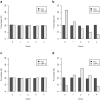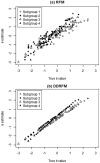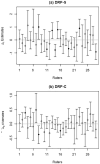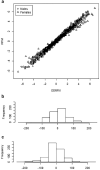Detecting Differential Rater Functioning in Severity and Centrality: The Dual DRF Facets Model
- PMID: 35754620
- PMCID: PMC9228693
- DOI: 10.1177/00131644211043207
Detecting Differential Rater Functioning in Severity and Centrality: The Dual DRF Facets Model
Abstract
Performance assessments heavily rely on human ratings. These ratings are typically subject to various forms of error and bias, threatening the assessment outcomes' validity and fairness. Differential rater functioning (DRF) is a special kind of threat to fairness manifesting itself in unwanted interactions between raters and performance- or construct-irrelevant factors (e.g., examinee gender, rater experience, or time of rating). Most DRF studies have focused on whether raters show differential severity toward known groups of examinees. This study expands the DRF framework and investigates the more complex case of dual DRF effects, where DRF is simultaneously present in rater severity and centrality. Adopting a facets modeling approach, we propose the dual DRF model (DDRFM) for detecting and measuring these effects. In two simulation studies, we found that dual DRF effects (a) negatively affected measurement quality and (b) can reliably be detected and compensated under the DDRFM. Using sample data from a large-scale writing assessment (N = 1,323), we demonstrate the practical measurement consequences of the dual DRF effects. Findings have implications for researchers and practitioners assessing the psychometric quality of ratings.
Keywords: Bayesian estimation; MCMC; differential rater functioning; rater bias.
© The Author(s) 2021.
Conflict of interest statement
Declaration of Conflicting Interests: The author(s) declared no potential conflicts of interest with respect to the research, authorship, and/or publication of this article.
Figures







References
-
- Beech J. R., Mackintosh I. C. (2005). Do differences in sex hormones affect handwriting style? Evidence from digit ratio and sex role identity as determinants of the sex of handwriting. Personality and Individual Differences, 39(2), 459–468. 10.1016/j.paid.2005.01.024 - DOI
-
- Congdon P. J., McQueen J. (2000). The stability of rater severity in large-scale assessment programs. Journal of Educational Measurement, 37(2), 163–178. 10.1111/j.1745-3984.2000.tb01081.x - DOI
-
- Eckes T. (2005). Examining rater effects in TestDaf writing and speaking performance assessments: A many-facet Rasch analysis. Language Assessment Quarterly, 2(3), 197–221. 10.1207/s15434311laq0203_2 - DOI
-
- Eckes T. (2015). Introduction to many-facet Rasch measurement: Analyzing and evaluating rater-mediated assessments (2nd ed.). Peter Lang.
LinkOut - more resources
Full Text Sources
